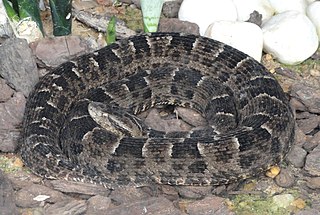
Craspedocephalus strigatus, commonly known as the horseshoe pit viper, is a venomous pitviper endemic to the Western Ghats. No subspecies are currently recognized.
Trimeresurus cantori, commonly known as the Cantor's pit viper, is a species of venomous snake, a pit viper in the family Viperidae. The species is endemic to the Nicobar Islands of India. It was named after Theodore Edward Cantor (1809-1860), a Danish naturalist serving as a surgeon with the East India Company in Calcutta. No subspecies are currently recognized.

Craspedocephalus macrolepis, commonly known as the large-scaled pit viper is a venomous pitviper species endemic to the Southern Western Ghats of South India. No subspecies are currently recognized.

Bothrops leucurus, commonly known as the whitetail lancehead or the Bahia lancehead, is a species of venomous snake, a pit viper in the family Viperidae. The species is endemic to Brazil. There are no subspecies which are recognized as being valid. A female owned by youtuber Venom Central is over six feet long.

The many-horned adder is a venomous viper species found in certain rocky desert areas, mostly along the Atlantic coast of southern Africa. They have characteristic tufts of "horns" above each eye. no subspecies are currently recognized.

Bitis peringueyi, also known as the Peringuey's adder, Peringuey's desert adder or sidewinding adder, is a venomous viper species found in Namibia and southern Angola. No subspecies are currently recognized.
Eryx elegans is a nonvenomous boa species endemic to western Central Asia. No subspecies are currently recognized.

Bothrops ammodytoides is a venomous pit viper species endemic to Argentina. No subspecies are currently recognized.

Crotalus oreganus, commonly known as the (northern) Pacific rattlesnake, is a venomous pit viper species found in western North America from the Baja California Peninsula to the southern interior of British Columbia.

Bothrops neuwiedi is a highly venomous pit viper species endemic to South America. This relatively small snake has a wide range and is a major source of snakebite in Argentina. It was named after German naturalist Prince Maximilian of Wied-Neuwied (1782-1867), who made important collections in Brazil (1815-1817). Seven subspecies are currently recognized, including the nominate subspecies described here.

Craspedocephalus puniceus is a venomous pitviper species endemic to Southeast Asia. Common names include: flat-nosed pitviper, flat-nosed pit viper, and ashy pit viper. No subspecies are currently recognized.

Trimeresurus sumatranus is a venomous pitviper species found in Thailand, Malaysia and Indonesia. Arboreal, its coloration is pale green with a red tail. Common names include Sumatran pitviper, Sumatran tree viper, and Sumatran pit viper.
Bothrops medusa is a venomous pitviper species endemic to Venezuela. No subspecies are currently recognized.

Bothrops oligolepis is a venomous pitviper species found in Peru and Bolivia. The specific name is derived from the Greek words oligo and lepis, meaning "few scales"; probably an allusion to the lower numbers of dorsal and ventral scales that it has compared to B. bilineatus. No subspecies are currently recognized.
Bothrops punctatus is a venomous pitviper species found in South America and Panama. No subspecies are currently recognized.
Bothrocophias andianus is a venomous pit viper species endemic to the Andes in South America. No subspecies are currently recognized.

Bothrops brazili is a venomous pitviper species endemic to South America. There are no subspecies that are recognized as being valid.
Bothrocophias campbelli, commonly known as Campbell's toadheaded viper, the Ecuadorian toadheaded pitviper, and víbora boca de sapo in Spanish, is a species of venomous pitviper in the family Viperidae. The species is endemic to South America. No subspecies are currently recognized.

Bothrops erythromelas, commonly known as the Caatinga lancehead or the jararaca-da-seca, is a species of venomous snake in the family Viperidae. It is endemic to Brazil. It belongs to reptile class.

Bothrops lutzi, the Cerrado lancehead, is a species of venomous snake in the family Viperidae. The species is endemic to Brazil.














